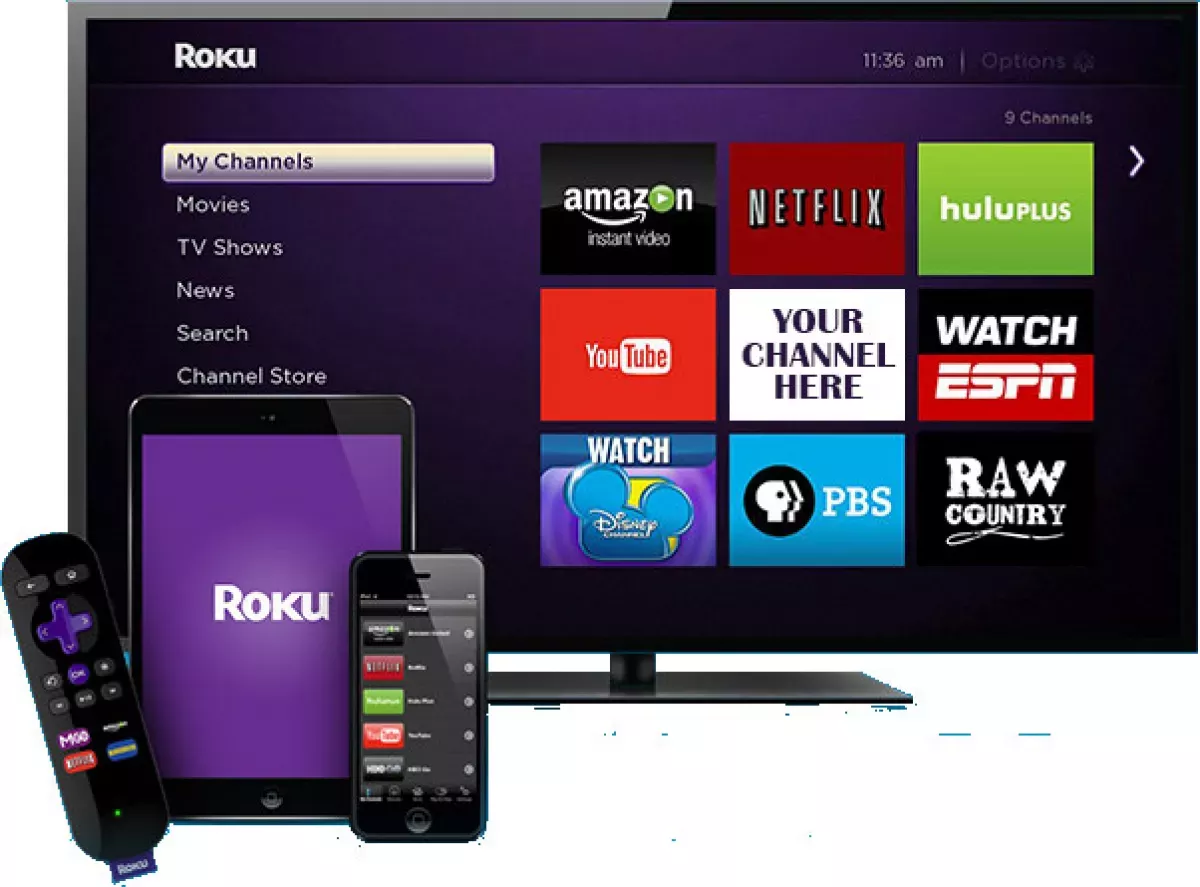Roku, Inc. is an American company that owns the Roku brand. Roku offers a range of consumer electronics products, primarily streaming players and smart TVs, allowing users to access a variety of streaming services. In addition to hardware, Roku also operates a free, ad-supported TV streaming service. The company is a prominent player in the streaming media device market, providing a platform for accessing diverse content sources on televisions.
2002: Roku Founded
In 2002, Anthony Wood founded Roku after previously founding ReplayTV.
2007: Project Griffin
In 2007, Anthony Wood's company worked with Netflix on Project Griffin, but Netflix cancelled it before launch due to potential licensing issues.
May 20, 2008: Roku DVP N1000 Unveiled
On May 20, 2008, the first Roku model, the Roku DVP N1000, was unveiled in partnership with Netflix. It was designed as a low-cost, small set-top box for Netflix's "Watch Instantly" service.
2008: First Roku Set-Top Box Released
In 2008, Roku released its first set-top box after being spun off from Netflix.
October 2009: New Roku Models Launched
In October 2009, Roku launched two new models: the Roku SD and the Roku HD-XR.
May 2010: Netflix Channel Update
In May 2010, the Netflix channel was updated to allow users to search the Netflix library directly from the device.
August 2010: 1080p Video Support
In August 2010, Roku announced plans to add 1080p video support to the HD-XR model.
2010: Models with Various Capabilities
In 2010, Roku began offering models with various capabilities, becoming their standard business model.
May 2011: Players Made
In May 2011, Roku mentioned it would stop updating players made in this month or earlier
July 2011: Second Generation of Players Unveiled
In July 2011, Roku unveiled its second generation of players, branded as Roku 2 HD, XD, and XS.
January 2012: Streaming Stick Unveiled
In January 2012, Roku unveiled the Streaming Stick, a new model condensed into a dongle form factor.
March 2013: Third-Generation Models Unveiled
In March 2013, Roku unveiled its third-generation models, the Roku 3 and Roku 2.
October 2014: Miracast Wireless Support
A software update in October 2014 added support for peer-to-peer Miracast wireless.
2014: Partnership with Smart TV Manufacturers
In 2014, Roku partnered with smart TV manufacturers to produce TVs with built-in Roku functionality.
2014: First Branded Smart TV Released
Roku's first branded smart TV was released in late 2014, manufactured by companies like TCL and using the Roku user interface.
September 2015: End of Support
In September 2015, Roku ended support for the first-generation Roku models.
October 2015: Roku 4 Introduced
In October 2015, Roku introduced the Roku 4 with upgraded hardware and support for 4K resolution video.
2015: Stop Updating
In 2015, Roku had warned that it would stop updating players made in May 2011 or earlier.
September 2016: Revamped Streaming Player Line-up
In September 2016, Roku revamped their entire streaming player line-up with five new models.
2016: Fifth-generation Premiere
In 2016, Roku released fifth-generation Premiere (4620) and Premiere+ (4630) models.
June 2017: Roku product sales banned in Mexico
In June 2017, a Mexico City court banned the sale of Roku products in Mexico, due to claims of copyright infringement related to illegal streaming services.
August 2017: Roku displays disclaimer for non-certified channels
In August 2017, Roku started displaying a disclaimer when non-certified channels are added, warning users about potential piracy risks.
October 2017: Sixth Generation of Products Introduced
In October 2017, Roku introduced its sixth generation of products, including the Streaming Stick+.
October 2017: Roku Channel Launched
In October 2017, Roku launched its own free, ad-supported streaming channel on its devices.
2017: Sixth-generation Products
In 2017, the sixth-generation products carrying over without any changes were the Express (3900), Express+ (3910), Streaming Stick (3800), and Streaming Stick+ (3810).
January 2018: Licensing Program for Smart Audio Devices
In January 2018, Roku debuted a new licensing program for smart audio devices.
May 2018: Software glitch causes copyright notices on legitimate services
In mid-May 2018, a software glitch caused some users to see copyright takedown notices on legitimate services such as Netflix and YouTube. Roku acknowledged and patched the glitch.
August 8, 2018: Roku Channel Available on the Web
On August 8, 2018, the Roku Channel became available on the web.
September 2018: Seventh Generation of Products Introduced
In September 2018, Roku introduced the seventh generation of products, carrying over some models and resurrecting the Premiere name.
October 2018: Mexico City court overturns Roku sales ban
In October 2018, the 11th Collegiate Court in Mexico City overturned the ban on Roku sales, allowing Roku to return to the Mexican market.
January 2019: Premium Subscription Options Added
In January 2019, premium subscription options from select content providers were added to the Roku Channel.
September 2019: Eighth Generation of Products Introduced
In September 2019, Roku introduced the eighth generation of products.
November 14, 2019: Walmart and Roku Partner
On November 14, 2019, Walmart and Roku announced that they would be selling Roku TVs under the Onn brand.
December 1, 2019: Netflix Ends Support for Older Roku Models
On December 1, 2019, Netflix announced that it would stop supporting older generations of Roku devices.
2019: Roku Express
In 2019, Roku Express was released to the public.
January 2020: Roku TV Certification Badge
In January 2020, Roku created a badge to certify devices as working with a Roku TV model.
April 7, 2020: Roku Channel Launched in the UK
On April 7, 2020, the Roku Channel launched in the UK with a different selection of content.
May 2020: HBO Max launch and unavailability on Roku
In May 2020, HBO Max launched but was unavailable on Roku due to disputes over revenue sharing.
May 2020: Outdoor Element Roku TV Announced
In May 2020, Roku announced a 55-inch outdoor Element Roku TV.
July 2020: Peacock launch and unavailability on Roku
In July 2020, NBCUniversal launched Peacock, which was initially unavailable on Roku due to a carriage dispute.
September 18, 2020: Roku announces removal of NBCUniversal TV Everywhere services
On September 18, 2020, Roku announced that NBCUniversal TV Everywhere services would be removed from its devices due to a dispute over carrying Peacock. An agreement was later reached that day.
September 28, 2020: Ninth Generation of Products Introduced
On September 28, 2020, Roku introduced the ninth generation of products, including the Roku Streambar.
December 2020: HBO Max launches on Roku
On December 17, 2020, HBO Max began streaming on Roku after a deal was reached with WarnerMedia the previous day.
December 2020: Dispute causes Spectrum TV app unavailability on Roku
Starting in mid-December 2020, a dispute caused the Spectrum TV streaming app to be unavailable for download on Roku devices for new customers.
2020: Identical Issue for Roku TVs
In 2020, another identical issue was reported for Roku TVs made by TCL.
January 8, 2021: Acquisition of Quibi's Content Library
On January 8, 2021, Roku acquired the original content library of Quibi, rebranding it as Roku Originals.
January 2021: Smart TVs Sold
In January 2021, a Roku executive said one out of three smart TVs sold in the United States and Canada came with Roku's operating system built-in.
April 14, 2021: Roku Express 4K+ Announced
On April 14, 2021, Roku announced the Roku Express 4K+, the Voice Remote Pro, and Roku OS 10.
April 30, 2021: Roku removes YouTube TV from Channels Store
On April 30, 2021, Roku removed YouTube TV from its Channels Store, citing anti-competitive demands from Google.
August 17, 2021: Resolution of Spectrum TV app dispute
On August 17, 2021, the dispute causing the Spectrum TV app's unavailability on Roku was resolved.
September 20, 2021: Tenth Generation of Products Introduced
On September 20, 2021, Roku introduced the tenth generation of products, including the Roku Streaming Stick 4K and Roku OS 10.5.
November 15, 2021: Roku LE Budget Model Announced
On November 15, 2021, Roku announced a budget model Roku LE (3930S3) to be sold at Walmart.
December 8, 2021: Roku and Google settle dispute, YouTube TV restored
On December 8, 2021, Roku and Google announced they had settled their dispute and reached a multi-year agreement, restoring the YouTube TV app on Roku.
2021: Roku as Market Leader
According to CNBC in 2021, Roku was the U.S. market leader in streaming video distribution.
March 2022: Private channel system deprecated
In March 2022, Roku deprecated its private channel system due to abuse, replacing it with a more limited beta channels platform.
March 2023: Partnership with Best Buy
In March 2023, Roku announced a partnership with Best Buy to exclusively sell Roku Select and Plus Series TVs.
June 2024: Roku OS Update
In June 2024, a Roku OS update added "motion smoothing", reportedly ruining the Roku TV experience.
July 2024: The Verge: Roku OS Update
According to The Verge in July 2024, a Roku OS update in June 2024 had "ruined" the Roku TV experience.
August 2024: Ease of Use
In August 2024, a Wired review noted that ease of use was one of the main reasons to buy any Roku product.
2024: Roku U.S. Market Leader
As of 2024, Roku is the U.S. market leader in streaming video distribution, reaching nearly 145 million people.
February 2025: Streaming Households Reached
In February 2025, Roku said it reached more than 90 million streaming households, with The Roku Channel reaching households with nearly 145 million people.
Mentioned in this timeline
Best Buy is a multinational consumer electronics retailer founded in...
Home Box Office HBO is an American pay television service...

Google LLC is a multinational technology company specializing in online...

Walmart Inc is a multinational retail corporation operating hypermarkets discount...
CNBC is an American business news channel owned by NBCUniversal...

Samsung Group is a South Korean multinational manufacturing conglomerate and...
Trending

Simon Cowell is a prominent English television personality and businessman recognized for his role as a judge on various talent...

7 months ago Gary Payton Reflects on Jordan Matchup and Hypothetical Stats in Today's NBA

11 days ago Spurs Defeat Nuggets in Thrilling Game, Mavericks Face Nuggets

22 days ago Michael Douglas and Catherine Zeta-Jones Celebrate 25 Years of Marriage with Throwbacks
Luke Kornet is an American professional basketball player currently playing for the San Antonio Spurs in the NBA He's a...

6 months ago Jack Black's Minecraft Movie Sets Premiere on HBO Max, June 20, 2025
Popular

Candace Owens is an American conservative political commentator and author...

Ilhan Omar is an American politician currently serving as the...

XXXTentacion born Jahseh Dwayne Ricardo Onfroy was a controversial yet...

Tom Cotton is an American politician and Army veteran currently...
The Kennedy Center Honors are annual awards recognizing individuals and...

Kelsey Grammer is an accomplished American actor producer and singer...
